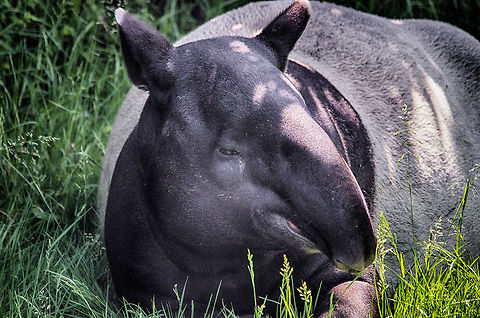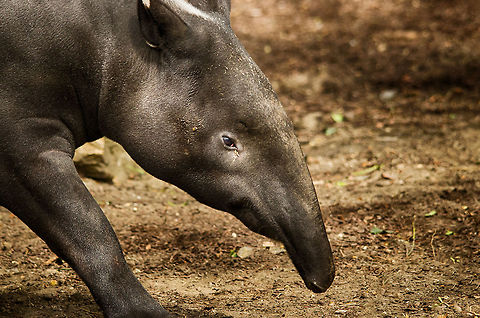
Appearance
The animal is easily identified by its markings, most notably the light-colored patch which extends from its shoulders to its rear end. The rest of its hair is black, except for the tips of its ears, which, as with other tapirs, are rimmed with white. This pattern is for camouflage; the disrupted coloration makes it more difficult to recognize it as a tapir, and other animals may mistake it for a large rock rather than prey when it is lying down to sleep.Malayan tapirs grow to between 1.8 and 2.4 m in length, not counting a stubby tail of only 5 to 10 cm in length, and stand 90 to 107 cm tall. They typically weigh between 250 and 320 kg, although some adults can weigh up to 540 kg. The females are usually larger than the males. Like the other types of tapirs, they have small, stubby tails and long, flexible proboscises. They have four toes on each front foot and three toes on each back foot. The Malayan tapir has rather poor eyesight, but excellent hearing and sense of smell.
They have a large sagittal crest, a bone running along the middle of the skull that is necessary for muscle attachment. They also have unusually positioned orbits, an unusually shaped cranium with the frontal bones elevated, and a retracted nasal incision. All of these modifications to the normal mammal skull are, of course, to make room for the proboscis. This proboscis caused retraction of bones and cartilage in the face during the evolution of the tapir, and even caused the loss of some cartilages, facial muscles, and the bony wall of the nasal chamber.

Naming
In the Malay language, the tapir is commonly referred to as "cipan", "tenuk" or "badak tampung".
Behavior
Malayan tapirs are primarily solitary creatures, marking out large tracts of land as their territory, though these areas usually overlap with those of other individuals. Tapirs mark out their territories by spraying urine on plants, and they often follow distinct paths which they have bulldozed through the undergrowth.Exclusively herbivorous, the animal forages for the tender shoots and leaves of more than 115 species of plants, moving slowly through the forest and pausing often to eat and note the scents left behind by other tapirs in the area. However, when threatened or frightened, the tapir can run quickly, despite its considerable bulk, and can also defend itself with its strong jaws and sharp teeth. Malayan tapirs communicate with high-pitched squeaks and whistles. They usually prefer to live near water and often bathe and swim, and they are also able to climb steep slopes. Tapirs are mainly active at night, though they are not exclusively nocturnal. They tend to eat soon after sunset or before sunrise, and they will often nap in the middle of the night. This behavior characterizes them as crepuscular animals.

Habitat
The Malayan tapir was once found throughout the tropical lowland rainforests of Southeast Asia, including Cambodia, Indonesia, Laos, Malaysia, Myanmar, Thailand, and Vietnam. However, its numbers have decreased in recent years, and today, like all tapirs, it is in danger of extinction.Because of their size, tapirs have few natural predators, and even reports of killings by tigers are scarce. The main threat to the Malayan tapirs is human activity, including deforestation for agricultural purposes, flooding caused by the damming of rivers for hydroelectric projects, and illegal trade. In Thailand, for instance, capture and sale of a young tapir may be worth US$5500.00. In areas such as Sumatra, where the population is predominantly Muslim, tapirs are seldom hunted for food, as their physical similarity to pigs has made tapir meat a taboo, but in some regions they are hunted for sport or shot accidentally when mistaken for other animals. Protected status in Malaysia, Indonesia, and Thailand, which seeks to curb deliberate killing of tapirs but does not address the issue of habitat loss, has had limited effect in reviving or maintaining the population.
References:
Some text fragments are auto parsed from Wikipedia.